
A joint investigation by the Humane Society of the United States and the Humane Society International in which members participated in an undercover operation revealed, a few days ago, what can only be described as a huge garbage can of the trophy hunting industry.
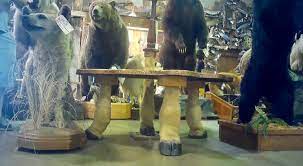
A four-day event where thousands of animals - including at least 557 hunting trophies relating to mammals no longer of interest to those who killed them - were sold to the highest bidders. The shelves and bins were filled with discarded trophies, including endangered and endangered species like elephants and polar bears, other endangered species like giraffes and hippos, and countless trophies from American wildlife such as grizzly bears, black bears, and mountain lions.
The items auctioned were in a grotesquely decorated house where one could see equally grotesque and distressingly sad furniture such as tables and lamps made of African elephant feet and feet. giraffe, or a young giraffe taxidermy. The auction also featured at least 50 rugs made from animals, including black bears, grizzly bears, zebras, wolves and mountain lions. The investigator saw piles of giraffe leg bones, sets of hippo teeth and a dusty box labeled "elephant ears and skin" .
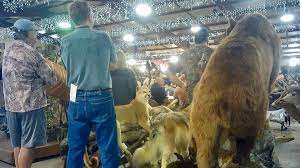
Kitty Block, President and CEO of The Humane Society of the United States, said : "It is unacceptable that not only the species of threatened and endangered wild animals are killed by hunters of trophies, but on top of that, the memorabilia from those hunts are eventually smuggled in and sold in a fairground filled with people who have no compassion for animals. This massive display of animal death is an unbearable picture, a devastating snapshot of what it looks like when species are pushed to the brink of extinction. "
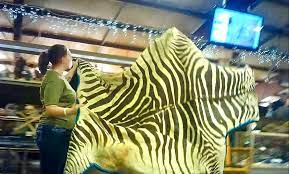
The undercover investigator has learned that most trophies are the result of trophy hunters tired of their collections, downsizing or dying and leaving these items to family members who don't want them. An auction staff member said, "Realtors tell homeowners to get rid of these dead creatures" when they stage their homes for sale.
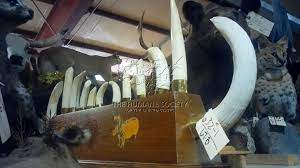
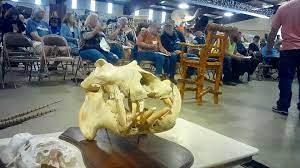
The auction included the following trophies:
- Four African elephant feet turned into tables with elephant skin tops. According to the International Union for the Conservation of Nature, the African savanna elephant is endangered and the African forest elephant is critically endangered. The African elephant is listed as threatened under the US Endangered Species Act.
- Two hollowed-out elephant feet which, according to the organizers of the auction, "would make a beautiful trash".
- A polar bear (considered vulnerable by IUCN and listed as threatened under ESA) with a ringed seal sold for $ 26,000, the highest price of any trophies sold at auction.
- Four giraffe feet made into a matching coffee table and floor lamp set.
- A large cardboard box labeled “elephant ears and skin”.
- Two giraffe skulls and three full giraffe bodies (IUCN vulnerable), including a baby promoted as "the perfect size that can fit in any room in the house," sold for $ 6,200.
- Giraffe leg bones promoted as "great for crafting."
- A hippo skull and two hippo shoulders (IUCN vulnerable) (head, neck, shoulders). Two sets of hippopotamus teeth.
- Baby zebra taxidermy, six zebra skins and rugs, including one from a calf, and several zebra heads for “tabletop display”.
- Six monkeys, including a stuffed vervet holding a beer bottle.
- Two babies and an adult baboon.
- 49 bears including five cubs and a mother-cub pair.
- 18 grizzly or black bear rugs.
- Bear claws are touted as "great for jewelry or crafts."
- Seven bobcats, including two carpets.
- Four wolves, including two carpets.
- Eight mountain lions, including two carpets.
Jeffrey Flocken, President of Humane Society International, said: “It is deeply sad to see this latest stage in the trophy hunting industry where these majestic species are relegated to an auction house floor instead of fulfill their role in their respective populations and ecosystems. "
"The United States is the largest importer of hunting trophies and should act quickly to get rid of this horrible distinction," said Sara Amundson, president of the Humane Society Legislative Fund. "The vote on the PROTECT Act in Congress is the most decisive way, because it would ban the import of trophies of all species listed as threatened or endangered under the US Act on endangered species in the USA. At the same time, the Fish and Wildlife Service should immediately revise its trophy import regulations to support the same conservation objective in order to put an end to this activity. A person's desire to have an animal wall rack in their living room or an elephant foot side table in no way justifies such carnage and waste of animal life.
The Facts:
- There are about 68,000 mature giraffes in the wild, and the population is still declining, but more than 40,000 parts and giraffes products were imported into the United States between 2006 and 2015.
- In October 2021, the Humane Society International and The Humane Society of the United States, in cooperation with other conservation organization, sued the US Fish and Wildlife Service for not having responded to a 2017 petition aimed at providing protections for giraffes under the Endangered Species Act.
- The population of African savannah elephants has decreased by at least 60% over the past 50 years, but according to the data of international trade, hunters trophies US imported more than 700 trophies and 399 tusks African elephants between 2014 and 2018.
- Hippo populations are vulnerable;
- the added pressure of trophy hunters and the international ivory trade could lead to a decline in population, but according to the data of international trade in hunting trophies and other parts of 2500 were hippos imported into the United States between 2009 and 2018.
- Nearly half a million black bears have been driven to the US between 2010 and 2020 in 33 states.
Posted on 2021-11-09 11:07








Comments